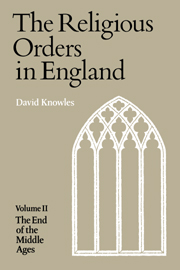Book contents
- Frontmatter
- Contents
- Preface
- List of Abbreviations
- Part One The Historical Framework
- Part Two The Institutional Background
- Chap. XVII Recruitment, employment and the horarium
- Chap. XVIII The wage-system and the common life
- Chap. XIX The election and privileges of the superior
- Chap. XX The numbers of the religious
- Chap. XXI Literary work
- Chap. XXII The monasteries and society
- Chap. XXIII Vicarages, the cure of souls and schools
- Chap. XXIV Public obligations of heads of houses
- Chap. XXV The monastic economy, 1320–1480
- Chap. XXVI Monastic Libraries
- Chap. XXVII Retrospect
- Appendix I Chaucer's monk
- Appendix II Henry V and the Westminster recluse
- Appendix III Regulars as bishops
- Bibliography
- Index
Chap. XVIII - The wage-system and the common life
Published online by Cambridge University Press: 28 January 2010
- Frontmatter
- Contents
- Preface
- List of Abbreviations
- Part One The Historical Framework
- Part Two The Institutional Background
- Chap. XVII Recruitment, employment and the horarium
- Chap. XVIII The wage-system and the common life
- Chap. XIX The election and privileges of the superior
- Chap. XX The numbers of the religious
- Chap. XXI Literary work
- Chap. XXII The monasteries and society
- Chap. XXIII Vicarages, the cure of souls and schools
- Chap. XXIV Public obligations of heads of houses
- Chap. XXV The monastic economy, 1320–1480
- Chap. XXVI Monastic Libraries
- Chap. XXVII Retrospect
- Appendix I Chaucer's monk
- Appendix II Henry V and the Westminster recluse
- Appendix III Regulars as bishops
- Bibliography
- Index
Summary
Although the horarium and the basic official employments of the monks were in 1500 still very much what they had been four centuries earlier, the framework and balance of the religious life had undergone profound changes. These derived in the main from two developments: the obedientiary system and the wage system. The first of these occupied our attention in a previous volume; it may be summarized by repeating that while at a house such as Christ Church, Canterbury, where there were well over a hundred monks, the vast majority c. 1150 were living the fully claustral life within the monastic enclosure, and only six or ten officials were in part exempt; two hundred years later, at the same house, now somewhat shrunken in numbers, there were among the priest-monks in active life two classes almost equal in size, those following the life of the cloister and those occupying one of the many administrative posts, with funds and often with estates to oversee. But in the intervening two centuries an internal disintegration or atomization had also begun to take place; the monks had begun to move in a journey that was to accomplish several stages before the last compulsory one; they were beginning to cross the space that separates a religious body with fully communal life from a college of clerks or a chapter of resident secular canons. This change had come about principally through the introduction of what may be called the ‘wage system’, accompanied by the appearance of a growing number of private apartments and even of private establishments within the monastic enclosure.
- Type
- Chapter
- Information
- Religious Orders Vol 2 , pp. 240 - 247Publisher: Cambridge University PressPrint publication year: 1979



